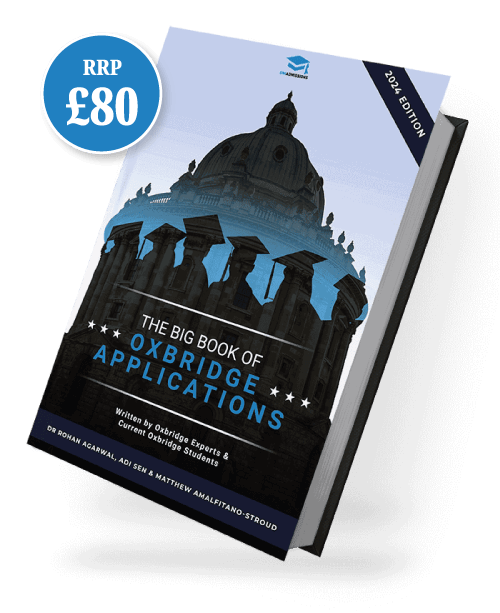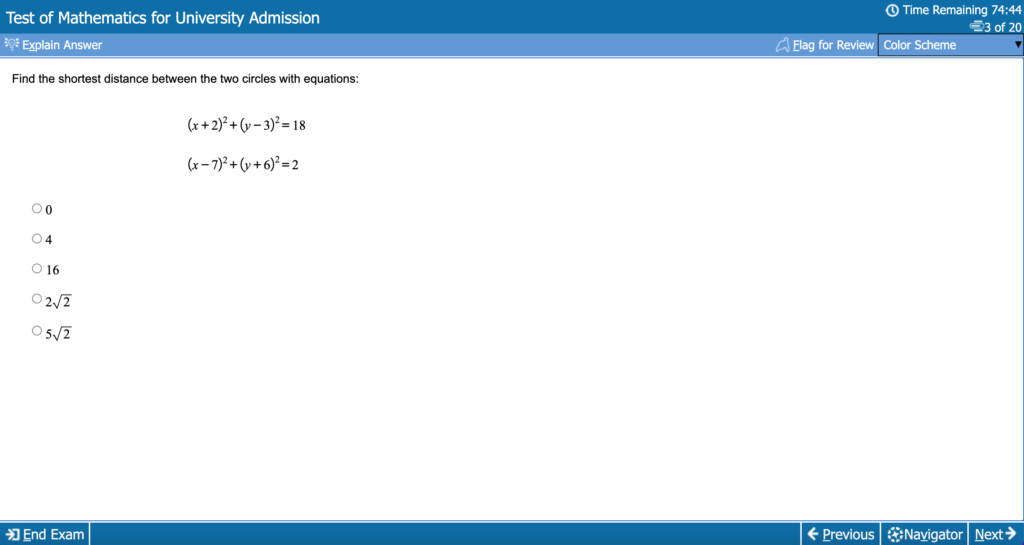Several different universities in the UK use the TMUA as part of their admissions process.
But what is the TMUA, and why do you have to sit it? In this guide, we’ll go over everything you need to know about the TMUA, from the format to the key dates. Let’s get started:
What is the TMUA?
The Test of Mathematics for University Admissions (TMUA) is designed to allow you to demonstrate that you have the essential mathematical thinking and reasoning skills needed for a demanding undergraduate Mathematics or mathematics-related course.
You are encouraged to take the TMUA when applying to study Mathematics or mathematics-related courses such as Economics and Computer Science at certain universities. The test is usually compulsory, although some courses/unis will consider it as an additional factor, not a requirement.
Which Universities Accept The TMUA?
Applicants for certain subjects at the University of Cambridge and Imperial College London will be required to sit the TMUA as part of their application. The subjects that require the TMUA are:
University of Cambridge
Imperial College London
London School of Economics (LSE)
- Economics
- Econometrics and Mathematical Economics
- Non-mandatory courses include Data Science, Actuarial Science & Maths Joint Honours
University of Warwick
- Computer Science
- Computer Science with Business Studies
- Discrete Mathematics
- Economics
- Economics, Politics and International Studies
- Economics and Management
- Mathematics
- Non-mandatory courses include Data Sciecne, Mathematics and Statistics & Mathematics, Operational Research, Statistics and Economics
University of Durham
Who Runs The TMUA?
The TMUA was previously run by Cambridge Assessments Admissions Test (CAAT) but has now been taken over by Person VUE, which creates and organises a wide range of computer-based tests across the globe. Their tests are all taken in specific testing centres owned by Pearson VUE. There are over 500 across the globe, including over 100 in the UK.
The TMUA itself actually falls under a sub-division of the company created to run university admissions tests – University Admissions Testing UK (UAT). Currently, UAT runs the TMUA and the Engineering & Science Admissions Test (ESAT). They also operates the University Clinical Aptitude Test (UCAT) for UK medical schools and the Law National Aptitude Test (LNAT) for UK law schools.
Enrolling on our Cambridge Economics comprehensive Programmes will give you access to TMUA support.
When you enrol on our Economics or Computer Science Programme, your Cambridge tutor will give you actionable feedback with insider tips on how to improve and score highly on the Admissions Test, as well as all other aspects of the application process, for the best chances of success.
Discover our Cambridge Programmes by clicking the button below to learn how you can enrol and triple your chances of success.
What Is The Format Of The TMUA?
The TMUA is two and a half hours long, made up of two papers which are taken consecutively. Since 2021, the test has been computer-based.
Paper 1 assesses applications of Mathematical knowledge and focuses on assessing your ability to apply your knowledge of Mathematics in new situations. You have 75 minutes for this paper to answer 20 multiple-choice questions.
Paper 2 assesses Mathematical reasoning and focuses on assessing your ability to deal with Mathematical reasoning and simple ideas from elementary logic. As with Paper 1, you have 75 minutes to answer 20 multiple-choice questions.
No calculators or dictionaries are allowed during the test, although paper will be provided for rough working out.
TMUA Testing Platform
The TMUA is run on a custom testing programme created by Pearson VUE, which you can see below:
On this platform, users are presented with questions one at a time, along with up to eight answer options. The top of the page contains the timer, indicating how much time you have left on the paper, and the flag button, which lets you highlight any question to go back to. The “Explain Answer” button isn’t a part of the actual test as it provides a worked solution to each question.
The bottom of the page features buttons to move to the next and previous question. Once all the questions on the paper have been completed, you will see the review screen. This screen shows the status of each question in the paper (answered, unanswered, flagged). This page lets you go back to any questions before the end of the time limit (you can also access the page via the “Navigator” button). Once time is up, you will be moved on to Paper 2 (or the end of the test).
Why Do I Have To Sit The TMUA?
Cambridge Economics and Computer Science applicants tend to be a bright bunch and therefore usually have excellent grades, with many having over 90% in all of their A-Level subjects.
Subsequently, competition is fierce, so Cambridge uses the TMUA to help differentiate between applicants who are otherwise academically indistinguishable.
Furthermore, the TMUA helps determine a candidate’s potential to achieve in an academically demanding undergraduate course. As already mentioned, if you are applying for a university where the TMUA is considered but not compulsory, a high score may mean you get a lower offer.
How Is The TMUA Used?
In most cases, your TMUA score will be automatically sent to the universities you’re applying to. This will be the case if the course requires a TMUA score to be submitted. If a TMUA score is not mandatory, you will have the option to choose if you want to submit it or not.
Your TMUA score will be used in different ways by universities as part of this admissions process. Most use your TMUA results alongside all aspects of your application. Others may use the results as a way to filter out candidates who did not achieve a certain score.
Access "The Big Book Of Oxbridge Applications" For FREE
The TMUA isn’t the only part of your Cambridge application. The Big Book Of Oxbridge Applications covers everything you need to know about applying to Cambridge and is available for free here! Through over 350 pages, you will find:
- 28 example Oxbridge Personal Statements
- Over 40 admissions test practice questions
- Interviews with Oxbridge students and graduates
- Additional downloadable resources
Fill out the form below to claim your digital copy today!

When And Where Do I Sit The TMUA?
The TMUA recently underwent some changes after the original exam organiser ceased operations and transferred responsibilities to Pearson VUE, who run the test under their University Admissions Tests UK (UAT) brand. While the exam format has not changed (other than it now being computer-based), various other aspects of the exam have.
The first of these changes is the testing dates. Previously, the TMUA was sat on a single day in October, but now there are two available testing periods, each of which runs for 2 days:
TMUA October 2024 Testing Dates
Registration Opens: 1st August 2024
Registration Closes: 16th September 2024
Testing Dates: 16th – 17th October 2024
TMUA January 2025 Testing Dates
Registration Opens: 24th October 2024
Registration Closes: 9th December 2024
Testing Dates: 8th – 9th January 2025
Candidates need register online via a Pearson VUE account by the deadline date for their testing period. Applicants for any university are able to sit the TMUA during the October period, but Cambridge applicants will not be able to sit the TMUA during the January period as this testing date runs after the Cambridge admissions process has completed.
You can only sit the TMUA once per admissions cycle, meaning you cannot resit the Admissions Test. This also means if you are reapplying the following year, you will have to take the TMUA once again.
In 2024, the TMUA will be sat within Pearson VUE testing centres. There are hundreds of centres located across the globe, including over 100 available in the UK. You will be able to see which is closest to you when you are booking your testing slot.
TMUA Costs
Anyone sitting the TMUA will have to pay a fee before the booking is confirmed:
TMUA Fee - UK Applicants
£75
TMUA Fee - Non-UK Applicants
£130
Bursary vouchers are available for applicants who receive certain forms of financial aid (such as universal credit or job seekers allowance) that cover the full cost of the booking. These need to be applied for before registration and before the registration deadline for the desired testing period.
How To Register For The TMUA?
Registration for the TMUA must be done via Pearson VUE’s online system. These are the steps you’ll need to take to do so:
1. Set Up A Pearson VUE account
To start with, you’ll need to create a Pearson VUE web account (or UAT account) on the official UAT website. This process requires you to submit personal and contact details, including your full legal name (as seen on any form of ID). You can also provide demographic and educational data should you wish to (this is used for research purposes).
2. Receive Confirmation and Candidate ID
Once your account has been made, you’ll receive a confirmation email within 24 hours. You’ll then be able to log in to your account, where you can make alterations to your account and view your candidate ID. You’ll need this ID when contacting customer services.
3. Book Your Test
Once the TMUA test bookings open, you will need to book your slot via your account. First, you will be required to select your nearest testing location (this will be based on your current location). Then you’ll have to choose from the available time/date slots that are available during the testing window (slots can get booked up if you register close to the deadline).
4. Pay For Your Test
You will have to pay a fee to sit the TMUA – this will need to be paid before your slot is confirmed. Once the fee has been paid (either by card or with a bursary voucher), you will receive a confirmation email.
How To Prepare For The TMUA
The focus of the TMUA is on Mathematical thinking.
It uses Mathematics you will have already learnt in your school studies, so there is no need to do much preparation beyond familiarising yourself with the test format and style of questions.
Reading the test specification and ‘Notes on Logic and Proof’ and answering practice questions under timed conditions are good places to start.
The ‘Notes on Logic and Proof’ document written by Cambridge Assessment Admissions Testing introduces and works through the Mathematical logic and methods of proof that you need to be comfortable with when sitting the TMUA.
Make sure to read and work through the examples and exercises, especially before attempting any Paper 2 questions, as this is assumed knowledge.
Before attempting any papers under timed conditions, make sure you are comfortable with the question format and style. This way, you can concentrate on getting more correct answers over how quickly you finish the paper.
Work through it step-by-step so that you thoroughly understand how to get to the answer, which will enable you to improve each time you tackle a past paper.
Once confident, move on to answering them under time conditions. This will allow you to gauge what sort of pace you need to work at in order to have enough time to answer each question.
You need to find a balance where you are not rushing but neither are you taking too long. Your pace will naturally increase with practice.
How Is The TMUA Scored?
There is no single pass or fail for the TMUA. Some universities will choose to set threshold scores (such as the University of Warwick), while others won’t place any cut-off (including the University of Cambridge). Your final scores are based on the number of correct answers you give. There is also no negative marking, so it is always worth making a guess.
Your score on the test will be based on your overall performance on both papers and will be given on a scale of 1.0 to 9.0, with 1.0 being the lowest and 9.0 the highest.
You will also be given a score for each of the two papers that make up the test, both on the 1.0 to 9.0 scale, but these two scores are for information only and do not form part of your formal test result.
Conclusion
You should now have a better idea of what the TMUA is and begin preparing for the Admissions Test. The application process is highly competitive, and the TMUA is an effective way for the Admissions Tutors to gauge a realistic representation of you.
It’s best to think of the Admissions Test as another opportunity to show the Admissions Tutors how impressive your Maths skills are rather than as another hurdle.
Our expert tutors are on hand to help you with all aspects of the Cambridge Economics application.
With our Cambridge Economics Premium Programme, we help you craft the perfect Personal Statement, perform strongly on the TMUA and teach you how to Interview effectively.
Discover our Cambridge Economics Premium Programme by clicking the button below to enrol and triple your chances of success.








